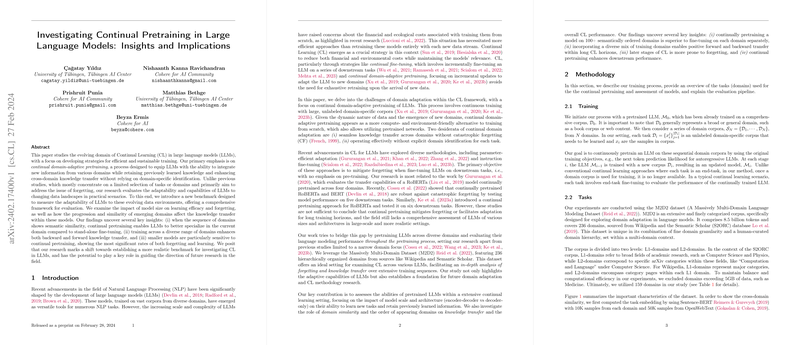Insights and Implications of Continual Pretraining in LLMs
The work "Investigating Continual Pretraining in LLMs: Insights and Implications" by Yıldız et al. constitutes a comprehensive exploration into the domain of Continual Learning (CL) and its integration within LLMs. As LLMs become pivotal in various NLP tasks, addressing the substantial financial and ecological costs associated with training them from scratch has gained importance. Continual Learning, especially through continual domain-adaptive pretraining, emerges as a viable solution, aiming to adapt LLMs to evolving data while minimizing forgetting and enhancing cross-domain knowledge transfer without requiring explicit domain identification.
Overview of Key Findings
This paper distinguishes itself by introducing a benchmark to assess LLMs' adaptability to continuously evolving data environments. It explores the impact of domain sequences and model sizes on learning efficacy and forgetting rates, yielding several key insights:
- Domain Order and Knowledge Transfer: The results underscore that continual pretraining on semantically ordered domains surpasses standard fine-tuning, optimizing both forward and backward knowledge transfer. However, randomizing domains during training can more effectively enhance the average performance through better backward transfer and overall generalization.
- Impact of Model Scale and Architecture: The paper finds a correlation between model size and continual learning performance. Larger models consistently deliver superior results, though exceptionally, smaller models exhibit pronounced forgetting and adaptability shifts, indicating potential scale-related trade-offs.
- Downstream Task Performance: Continual pretraining improves the LLMs' performance on downstream tasks, such as question-answering, highlighting the practicality of adaptive pretraining over isolated fine-tuning approaches for diverse application domains.
- Forgetting and Knowledge Saturation: A novel observation of knowledge saturation was noted, showing that continual pretraining can lead to enhanced transfer capabilities initially but eventually plateaus, leading to increased forgetting as the model endeavors to integrate new information over extended sequences.
Broader Implications and Future Speculations
The implications of this paper are manifold, influencing both practical applications and theoretical advancements. Practically, this research paves the way for adaptive pretraining strategies that could significantly alleviate the economic and environmental burdens of model re-training in response to changing data landscapes. Theoretically, it emphasizes the necessity for models to dynamically balance new knowledge acquisition with the retention of past expertise, a crucial insight for future model architecture design and CL methodologies.
Looking forward, future research might explore multiple domain orderings and their long-term effects on knowledge retention. Further explorations into model adaptations could consider leveraging optimized architectures that inherently resist catastrophic forgetting while preserving domain-spanning competencies. This paper indeed sets the stage for insightful advancements in developing LLMs that are not only larger and more capable but also adaptive and efficient learners in a constantly evolving world.
